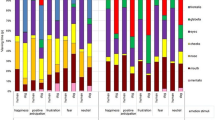Abstract
This paper reports on the use of an eye-tracking technique to examine how chimpanzees look at facial photographs of conspecifics. Six chimpanzees viewed a sequence of pictures presented on a monitor while their eye movements were measured by an eye tracker. The pictures presented conspecific faces with open or closed eyes in an upright or inverted orientation in a frame. The results demonstrated that chimpanzees looked at the eyes, nose, and mouth more frequently than would be expected on the basis of random scanning of faces. More specifically, they looked at the eyes longer than they looked at the nose and mouth when photographs of upright faces with open eyes were presented, suggesting that particular attention to the eyes represents a spontaneous face-scanning strategy shared among monkeys, apes, and humans. In contrast to the results obtained for upright faces with open eyes, the viewing times for the eyes, nose, and mouth of inverted faces with open eyes did not differ from one another. The viewing times for the eyes, nose, and mouth of faces with closed eyes did not differ when faces with closed eyes were presented in either an upright or inverted orientation. These results suggest the possibility that open eyes play an important role in the configural processing of faces and that chimpanzees perceive and process open and closed eyes differently.





Similar content being viewed by others
References
Adachi I, Chou DP, Hampton RR (2009) Thatcher effect in monkeys demonstrates conservation of face perception across primates. Curr Biol 19:1270–1273
Anastasi J, Rhodes MG (2005) An own-age bias in face recognition for children and older adults. Psychon Bull Rev 12:1043–1047
Bard K, Myowa-Yamokoshi M, Tomonaga M, Tanaka M, Costal A, Matsuzawa T (2005) Group differences in the mutual gaze of chimpanzees (Pan troglodytes). Dev Psychol 41:616–624
Batki A, Baron-Cohen S, Wheelwright S, Connellan J, Ahluwalia J (2000) Is there an innate gaze module? Evidence from human neonates. Inf Behav Dev 23:223–229
Bruce C (1982) Face recognition by monkeys: absence of an inversion effect. Neuropsychologia 20:515–521
Collishaw SM, Hole GJ (2000) Featural and configurational processes in the recognition of faces of different familiarity. Perception 29:893–909
Dahl CD, Logothetis NK, Hoffman KL (2007) Individuation and holistic processing of faces in rhesus monkeys. Proc R Soc B 274:2069–2076
Dahl CD, Wallraven C, Bülthoff HH, Logothetis NK (2009) Humans and macaques employ similar face-processing strategies. Curr Biol 19:509–513
De Waal FBM (1982) Chimpanzee politics: power and sex among apes. Jonathan Cape, London
De Waal FBM (1989) Peacemaking among primates. Harvard University Press, Cambridge
Diamond R, Carey S (1986) Why faces are and are not special: an effect of expertise. J Exp Psychol 115:107–117
Dittrich W (1990) Representation of faces in longtailed macaques (Macaca fascicularis). Ethology 85:265–278
Emery NJ (2000) The eyes have it: the neuroethology, function and evolution of social gaze. Neurosci Biobehav Rev 24:581–604
Farroni T, Csibra G, Simion F, Johnson MH (2002) Eye contact detection in humans from birth. Proc Natl Acad Sci USA 99:9602–9605
Gallup GG, Nash RF, Ellison AL (1971) Tonic immobility as a reaction to predation: artificial eyes as a fear stimulus for chickens. Psychon Sci 23:79–80
Goffaux V, Hault B, Michel C, Vuong QC, Rossion B (2005) The respective role of low and high spatial frequencies in supporting configural and featural processing of faces. Perception 34:77–86
Gómez JC (1996) Non-human primate theories of (non-human primate) minds: some issues concerning the origins of mind-reading. In: Carruthers P, Smith PK (eds) Theories of theories of mind. Cambridge University Press, Cambridge, pp 330–343
Goodall J (1986) The chimpanzees of Gombe: patterns of behavior. Harvard University Press, Cambridge
Gothard KM, Erickson CA, Amaral DG (2004) How do rhesus monkeys (Macaca mulatta) scan faces in a visual paired comparison task? Anim Cogn 7(1):25–36
Gothard KM, Brooks KN, Peterson MA (2009) Multiple perceptual strategies used by macaque monkeys for face recognition. Anim Cogn 12:155–167
Guo K, Robertson RG, Mahmoodi S, Tadmor Y, Young MP (2003) How do monkeys view faces? A study of eye movements. Exp Brain Res 150:363–374
Hainline L (1978) Developmental changes in visual scanning of face and nonface patterns by infants. J Exp Child Psychol 25:90–115
Hampton RR (1994) Sensitivity to information specifying the line of gaze of humans in sparrows (Passer domesticus). Behaviour 130:41–51
Hare B, Call J, Agnetta B, Tomasello M (2000) Chimpanzees know what conspecifics do and do not see. Anim Behav 59:771–785
Hirata S, Fuwa K (2007) Chimpanzees (Pan troglodytes) learn to act with other individuals in a cooperative task. Primates 48:13–21
Hirata S, Morimura N, Fuwa K (in press) Intentional communication and comprehension of the partner’s role in experimental cooperative tasks. In: Lonsdorf EV, Ross SR, Matsuzawa T (eds) The mind of the chimpanzees: ecological and experimental perspectives. The University of Chicago Press, Chicago
Jones RB (1980) Reactions of male domestic chickens to two-dimensional eye-like shapes. Anim Behav 28:212–218
Kaminski J, Call J, Tomasello M (2004) Body orientation and face orientation: two factors controlling apes’ begging behavior from humans. Anim Cogn 7:216–223
Kano F, Tomonaga M (2009) How chimpanzees look at pictures: a comparative eye-tracking study. Proc R Soc B 276:1949–1955
Kano F, Tomonaga M (in press) Face scanning in chimpanzees and humans: continuity and discontinuity. Anim Behav in press
Keating CF, Keating EG (1982) Visual scan patterns of rhesus monkeys viewing faces. Perception 11:211–219
Kobayashi H, Kohshima S (1997) Unique morphology of the human eye. Nature 6635:767–768
Martin-Malivel J, Fagot J (2001) Perception of pictorial human faces by baboons: effects of stimulus orientation on discrimination performance. Anim Learn Behav 29:10–20
Maurer D, Le Grand R, Mondloch CJ (2002) The many faces of configural processing. Trends Cogn Sci 6:255–260
Mondloch CJ, Le Grand R, Maurer D (2002) Configural face processing develops more slowly than featural processing. Perception 31:553–566
Myowa-Yamakoshi M, Tomonaga M, Tanaka M, Matsuzawa T (2003) Preference for human direct gaze in infant chimpanzees (Pan troglodytes). Cognition 89:B53–B64
Nahm FKD, Perret A, Amaral DG, Albright TD (1997) How do monkeys look at faces? J Cogn Neurosci 9:611–623
Parr LA, Dove T, Hopkins WD (1998) Why faces may be special: evidence of the inversion effect in chimpanzees. J Cogn Neurosci 10:615–622
Parr LA, Winslow JT, Hopkins WD (1999) Is the inversion effect in rhesus monkeys face-specific? Anim Cogn 2:123–129
Povinelli DJ, Bering JM, Giambrone S (2000) Toward a science of other minds: escaping the argument by analogy. Cogn Sci 24:509–541
Redican WK (1975) Facial expressions in nonhuman primates. In: Rosenblum LA (ed) Primate behavior, vol 4. Academic Press, New York, pp 103–194
Scaife M (1976a) The response to eye-like shapes by birds I: The effect of context, a predator and a strange bird. Anim Behav 24:195–199
Scaife M (1976b) The response to eye-like shapes by birds II: the importance of staring, pairedness and shape. Anim Behav 24:200–206
Senju A, Csibra G (2008) Gaze following in human infants depends on communicative signals. Curr Biol 18:668–671
Tomasello M, Call J, Hare B (2003) Chimpanzees understand psychological states—the question is which ones and to what extent. Trends Cogn Sci 7:153–156
Tomonaga M (1994) How laboratory-raised Japanese monkeys (Macaca fuscata) perceive rotated photographs of monkeys: evidence for an inversion effect in face perception. Primates 35:155–165
Tomonaga M (2007) Visual search for orientation of faces by a chimpanzee (Pan troglodytes): face-specific upright superiority and the role of facial configural properties. Primates 48:1–12
Valentine T (1988) Upside-down faces: a review of the effects of inversion on face recognition. Br J Psychol 79:471–491
Weiss DJ, Kralik JD, Hauser MD (2001) Face processing in cotton-top tamarins (Saguinus oedipus). Anim Cogn 4:191–205
Yin RK (1969) Looking at upside down faces. J Exp Psychol 81:141–145
Acknowledgments
This work was financially supported by the Ministry of Education, Culture, Sports, Science, and Technology of Japan (#20220004 and #20680015). We thank Kazuo Fujita, Shoji Itakura, and Masako Myowa-Yamakoshi for their support in conducting the experiment, Robert W. Shumaker for helpful comments on the manuscript, and the staff of the Great Ape Research Institute, Hayashibara Biochemical Laboratories, Inc. for support in conducting the experiment and for caring for the chimpanzees. All chimpanzees were cared for according to the Guide for the Care and Use of Laboratory Animals of Hayashibara Biochemical Laboratories, Inc. and the guidelines established by the Primate Society of Japan. The authors declare that they have no conflict of interest.
Author information
Authors and Affiliations
Corresponding author
Rights and permissions
About this article
Cite this article
Hirata, S., Fuwa, K., Sugama, K. et al. Facial perception of conspecifics: chimpanzees (Pan troglodytes) preferentially attend to proper orientation and open eyes. Anim Cogn 13, 679–688 (2010). https://doi.org/10.1007/s10071-010-0316-y
Received:
Revised:
Accepted:
Published:
Issue Date:
DOI: https://doi.org/10.1007/s10071-010-0316-y




